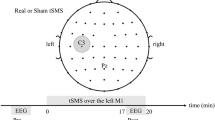Abstract
The systems responses of the brain to therapeutic transcranial electrical and electromagnetic stimulation were studied and the neurophysiological criteria for assessing the efficacy of this treatment were identified using comparative clinical and experimental studies with analysis of spontaneous bioelectrical activity, along with assessment of behavioral and clinical measures. Study groups consisted of six patients with chronic post-traumatic unconscious states during courses of transcranial electrical stimulation and 17 intact Wistar rats subjected to transcranial electromagnetic stimulation. A relationship was found between the effects of transcranial stimulation and the initial level of intercenter interactions of brain bioelectrical activity assessed in terms of coherence. Hypersynchronization of biopotentials, identified as a major element in the reactivity to this type of stimulation, may be of the greatest value in the recovery of patients with cerebral pathology in cases with initially reduced levels of intercenter interactions in the absence of pathologically increased functional connections in the brain.
Similar content being viewed by others
References
Z. A. Aleksanyan, E. B. Lyskov, G. V. Kataeva, F. A. Gurchin, I. G. Zavolokov, and S. V. Mozhaev, “Use of transcranial electromagnetic stimulation for the treatment of motor and speech disorders in patients after strokes,” Ros. Fiziol. Zh., 90, No. 8, 1–2 (2004).
Human Brain Biopotentials [in Russian], V. C. Rusinov (ed.), Meditsina, Moscow (1987).
V. G. Voronov, “Identification of statistically significant features in the frequency spectra of electroencephalograms and the application of these methods to clinical diagnostic tasks,” in: Proceedings of the 8th International Conference “New Information Technology in Medicine and Ecology” [in Russian], Gurzuf, Ukraine (2000), pp. 244–245.
R. F. Gimranov, Transcranial Magnetic Stimulation [in Russian], OOO PKF Allana, Moscow (2002).
T. N. Grechenko and E. D. Shekhter, “Effects of electric shock on the electrical activity of neurons in a mollusk,” in: Functional Organization of Brain Activity [in Russian], Nauka, Moscow (1975), pp. 137–138.
Yu. G. Grigor’ev, “Bioeffects associated with modulated electromagnetic fields in acute experiments,” in: Yearbook of the Russian National Committee for Protection from Non-Ionizing Radiation [in Russian], Moscow (2004), pp. 16–72.
A. Yu. Zaslavskii and G. S. Markarov, “The ‘Infita’ pulse-based low-frequency physiotherapy apparatus,” Med. Tekhnika, No. 5, 18–20 (1994).
V. P. Lebedev, “Transcranial electrostimulation: a new approach,” in: Tanscranial Electrostimulation [in Russian], P. D. Dvoretskii (ed.), I. P. Pavlov Institute of Physiology (GNPP “Iskusstvo Rossii”), St. Petersburg (1998), pp. 22–39.
S. S. Nikitina and A. L. Jurenkov, Magnetic Stimulation in the Diagnosis and Treatment of Nervous System Diseases [in Russian], ZAO InfoMed, Moscow (2003).
E. N. Sokolov and T. N. Grechenko, “Reversible weakening of post-tetanic reactions of a mollusk neuron after string direct hyperpolarizing stimulation”, Neirofiziologiya, 6, No. 2, 192–196 (1974).
Yu. A. Kholodov, “Neurobiological approaches to magnetotherapy,” in: The Magnetotherapy of Nervous System Diseases [in Russian], R. F. Gimranov (ed.), OOO PKF Allana, Moscow (2002), pp. 3–18.
E. V. Sharova, “Involvement of the frontal lobes in post-coma restoration of mental activity in humans,” in: Proceedings of the XXX All-Russia Congress on Problems in Higher Nervous Activity [in Russian], St. Petersburg (2000), Vol. 2, pp. 567–568.
E. V. Sharova, V. G. Amcheslavskii, A. A. Potapov, V. L. Anzimirov, O. S. Zaitsev, V. K. Emel’yanov, and V. A. Shabalov, “EEG effects of therapeutic electrostimulation of the CNS in post-traumatic unconsciousness,” Fiziol. Cheloveka, 27, No. 2, 29–39 (2001).
E. V. Sharova, M. R. Novikova, M. A. Kulikov, L. V. Shishkina, B. M. Sidorov, and A. V. Mel’nikov, “Reaction of the rat brain to acute stem injury in terms of measures of the dynamics of cerebral electrical activity,” Zh. Vyssh. Nerv. Deyat., 53, No. 2, 228–239 (2003).
Yu. Yaroslavskii and R. Kh. Bel’meker, “Transcranial magnetic stimulation in psychiatry,” Zh. Nevrol. Psikhiatr., 97, No. 6, 68–70 (1997).
O. Grindel, N. Romanova, O. Zaitsev, V. Voronov, and I. Skoriatina, “EEG-mathematical analysis of psychopathological syndromes in severely head-injured patients,” in: Neurotrauma, A. Potapov and L. Likhterman (eds.), K. R. H. von Wild-Antidor, Moscow (2002), pp. 125–133.
J. Jenkins, P. M. Shajahan, J. M. Lappin, and K. P. Ebmeier, “Right and left prefrontal transcranial magnetic stimulation at 1 Hz does not affect mood in healthy volunteers,” BMC Psychiatry, 2, No. 1, 1–5 (2002).
H. Jing, M. Takigawa, K. Hamada, H. Okamura, and Y. Kawaika, “Effects of high frequency repetitive transcranial magnetic stimulation on P300 event-related potentials,” Clin. Neurophysiol., 112, 304–317 (2001).
S. Kohler, T. Paus, R. L. Burckner, and B. Milner, “Effects of left inferior prefrontal stimulation on episodic memory formation: a two-stage fMRI-rTMS study,” J. Cogn. Neurosci., 16, No. 2, 178–188 (2004).
T. Tsubokawa, “Deep brain stimulation therapy for a persistent vegetative state,” J. Neurotrauma, 12, No. 3, 345 (1995).
Author information
Authors and Affiliations
Additional information
__________
Translated from Zhurnal Vysshei Nervnoi Deyatel’nosti imeni I. P. Pavlova, Vol. 56, No. 3, pp. 363–370, May–June, 2006.
Rights and permissions
About this article
Cite this article
Sharova, E.V., Mel’nikov, A.V., Novikova, M.R. et al. Changes in spontaneous brain bioelectrical activity during transcranial electrical and electromagnetic stimulation. Neurosci Behav Physiol 37, 451–457 (2007). https://doi.org/10.1007/s11055-007-0034-3
Received:
Accepted:
Issue Date:
DOI: https://doi.org/10.1007/s11055-007-0034-3




